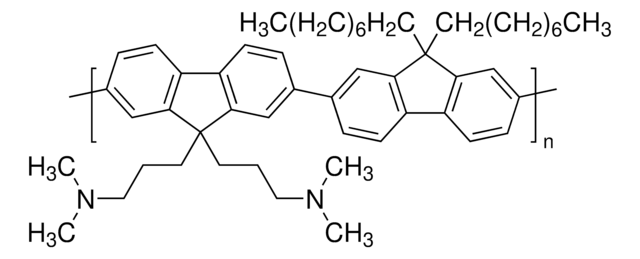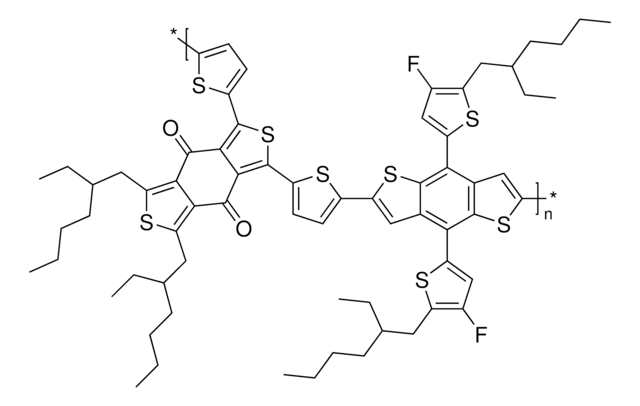Key Documents
906980
PFN-Br
Synonim(y):
OS0995, PFN-P2, Poly(9,9-bis(3’-(N,N-dimethyl)-N-ethylammoinium-propyl-2,7-fluorene)-alt-2,7-(9,9-dioctylfluorene))dibromide
About This Item
Polecane produkty
Postać
solid
masa cząsteczkowa
Mw 30,000-50,000 by GPC
charakterystyka ekologicznej alternatywy
Design for Energy Efficiency
Learn more about the Principles of Green Chemistry.
sustainability
Greener Alternative Product
kolor
beige to yellow
mp
>200 °C
rozpuszczalność
DMF: soluble
DMSO: soluble
alcohol: soluble
chloroform: insoluble
water: soluble
PDI
2‑3.2
kategoria ekologicznej alternatywy
, Enabling
Szukasz podobnych produktów? Odwiedź Przewodnik dotyczący porównywania produktów
Opis ogólny
Zastosowanie
OPV devices with PFN-Br interfacial layer showed overall enhanced short-circuit current density, open-circuit voltage, fill factor and corresponding high efficiency in the inverted OPVs. This was attributed to the good contact between ZnO electron extraction layer and the active layer, good interface adhesion between the electron extraction layer and active layer, and enhanced charge transport via suppressed bimolecular recombination.
Recent report of OPV with a record energy conversion efficiency of 17.3% also utilized PFN-Br, spin-coated on top of ZnO to improve the interfacial properties.
Tandem Cell Device performance:
ITO/ZnO/PFN-Br/PBDB-T:F-M/M-PEDOT/ZnO/PTB7- Th:O6T-4F:PC71BM/MoO3/Ag
Voc=1.642 V
Jsc=14.35 mA/cm2
FF=73.7%
PCE=17.3%
PFN-Br finds application in a wide range of areas:
- OPV interficial layer (metalic oxide compact layer)
- OLED electron transport layer
- Perovskite solar cells
- Flexible printed electronics
- Cationic polymer electrolyte
- Anion exchange material
- Light emitting electrochemical cells
Inne uwagi
Kod klasy składowania
11 - Combustible Solids
Klasa zagrożenia wodnego (WGK)
WGK 3
Temperatura zapłonu (°F)
Not applicable
Temperatura zapłonu (°C)
Not applicable
Wybierz jedną z najnowszych wersji:
Certyfikaty analizy (CoA)
Nie widzisz odpowiedniej wersji?
Jeśli potrzebujesz konkretnej wersji, możesz wyszukać konkretny certyfikat według numeru partii lub serii.
Masz już ten produkt?
Dokumenty związane z niedawno zakupionymi produktami zostały zamieszczone w Bibliotece dokumentów.
Klienci oglądali również te produkty
Produkty
Professor Chen (Nankai University, China) and his team explain the strategies behind their recent record-breaking organic solar cells, reaching a power conversion efficiency of 17.3%.
Nasz zespół naukowców ma doświadczenie we wszystkich obszarach badań, w tym w naukach przyrodniczych, materiałoznawstwie, syntezie chemicznej, chromatografii, analityce i wielu innych dziedzinach.
Skontaktuj się z zespołem ds. pomocy technicznej




![[6,6]-Phenyl C61 butyric acid methyl ester ≥99%](/deepweb/assets/sigmaaldrich/product/structures/359/221/d990c746-0960-4c69-bf76-fe09b193824d/640/d990c746-0960-4c69-bf76-fe09b193824d.png)







